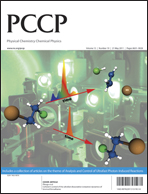Conformational transitions of glycine induced by vibrational excitation of the O–H stretch†
Abstract
Vibrational energy flow and conformational transitions following excitation of the OH stretching mode of the most stable conformer of

- This article is part of the themed collection: Analysis and Control of Ultrafast Photon-Induced Reactions

 Please wait while we load your content...
Please wait while we load your content...